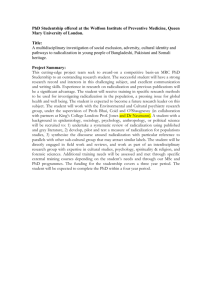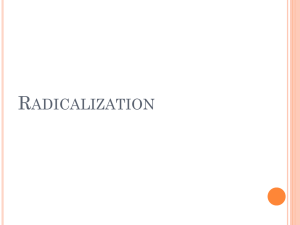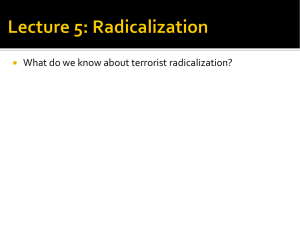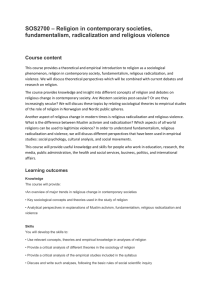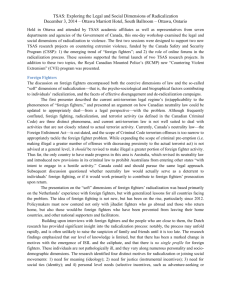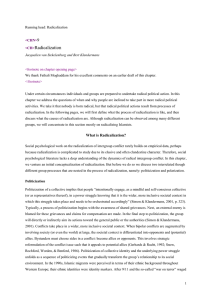Making Terrorists: Best Practices
advertisement
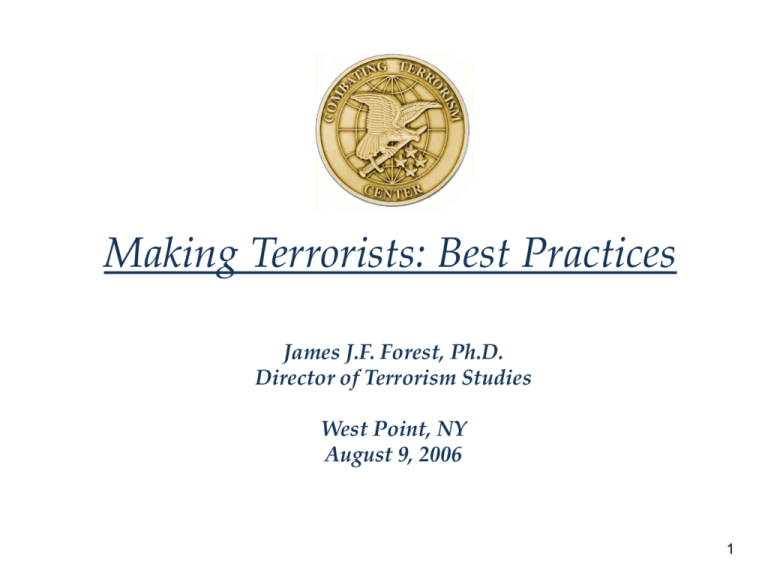
Making Terrorists: Best Practices James J.F. Forest, Ph.D. Director of Terrorism Studies West Point, NY August 9, 2006 1 Making Terrorists: Best Practices • What do we know about the transformation of an ordinary person into a terrorist? – A terrorist needs to develop the will to kill: motivational learning – A terrorist needs to develop the skill to kill: operational learning • We can counter the will to kill (indoctrination, radicalization), but not the skill to kill (can't "unlearn" how to drive a car) • Thus, it is important to identify, recognize symptoms of the radicalization process, the development of violent intentions, and find opportunities to effectively intervene in that process 2 What do we know about radicalization in the terrorist world? • Because these are learning organizations, we know that they learn from each other. • If I were a member of this terrorist world, I would seek out whatever learning resources I could find about best practices of radicalization and terrorist recruitment. • And, lucky me, there are literally thousands of terrorist group websites and publications available throughout the world, some offering their messages in multiple languages, and all of which demonstrate effective ideological marketing practices. • In general, these materials seek to establish a rationale for their use of violence in pursuit of particular goals and objectives. • In addition to written appeals for action, images, music, speeches and videos are also used to persuade—or at least connect with—a website visitor on an emotional and intellectual level. 3 If I were to write a central reference volume of radicalization, what would it look like? Table of Contents Radicalizing New Members A Compilation of Best Practices and Guidance for Terrorist Organizations PART I: Means and Places of Radicalization PART II: Case Studies PART III: Best Practices and Lessons Learned Published by the Global Terrorism Media Front 4 Radicalizing New Members PART I: Means and Places of Radicalization 1 – Places of Worship (mosque, church, synagogue); special importance because of interpretation power 2 – Places of Political Ideas and Learning (school, madrasa, university) 3 – Places of Shared Purpose and Bonds (places of work, community centers, soccer leagues, prisons) 4 – Communities, Families, Social Networks (dinner table, local picnic) 5 – The Internet (open access to publishers and seekers of info) 6 – Unique Places (training camps, secret facilities, al Manar) As Marc Sageman and other researchers have observed, all of these produce groups of like-minded individuals whose shared purpose and experiences build lifelong trust and a sense of “us, together against the world” among its members. 5 PART II: Case Studies Irish Republican Army Hizballah ETA (Basque Separatists) LEHI, Stern Gang and Zvi Irgun (Jewish extremists) Tamil Tigers (LTTE) Sendero Luminoso FARC MRTA (Tupac Amaru movement) Al Qaida Jemaah Islamiya Aum Shinrikyo Moro Islamic Liberation Front Egyptian Islamic Jihad Algerian GIA and GSPC Syrian Muslim Brotherhood Hizb ut-Tahrir Al Qaeda in Iraq Lashkar-e Taiba (and other Kashmir groups) Islamic Movement of Uzbekistan Italian Red Brigades Red Army Faction (Baader Meinhof Gang) U.S.-based militia groups The Order, the Aryan Brotherhood, Christian Identity, The Sword, the Covenant & Arm of the Lord Others? 6 PART III: Best Practices and Lessons Learned • Start the radicalization process when young • So-called "seekers" of any age are prime candidates for becoming radicalized (you know what a seeker is; you know a seeker, looking for something that is not in his or her life; searching for meaning, purpose, etc.) • Family radicalization is more effective than focusing on a single individual (bonds of blood) • Radicalization of any kind requires local context (but not necessarily local hardships); e.g., London vs. Kashmir 7 Radicalizing New Members PART III: Best Practices and Lessons Learned • Radicalization involves a new or different vision of the future (a future that cannot be achieved w/out violence) • Radicalization is rooted in information, beliefs and perceptions, and interpretation (hence the important role of churches, schools) • Emotions are more powerful than intellectual appeals (motivated by feelings, not rationale) • Images are often more powerful than words 8 Radicalizing New Members PART III: Best Practices (Cont.) • All insurgencies require some form of radicalization • A government can radicalize its people (e.g., Nazi Germany) • Effective radicalization typically needs a charismatic leader or figurehead (However, he/she might not necessarily be the source of ideology, but the key transmitter/interpreter of it) • Radicalization requires funding • Radicalization requires purpose 9 Radicalizing New Members PART III: Best Practices (Cont.) • Religious ideologies are the most powerful radicalization agents, because they: 1. Explain the state of the world, particularly why believers are continuously persecuted, oppressed or discriminated 2. Explain how and why violence may be condoned and necessary 3. Are often theologically supremacist - meaning that all believers assume superiority over non-believers, who are not privy to the truth of the religion 4. Are exclusivist - believers are a chosen people, or their territory is a holy land 5. Are absolutist - it is not possible to be a half-hearted believer, and you are either totally within the system, or totally without it (and only the true believers are guaranteed salvation and victory, whereas the enemies and the unbelievers - as well as those who have taken no stance whatsoever - are condemned to some sort of eternal punishment or damnation, as well as death) • Overall, religious ideologies help foster polarizing values in terms of right and wrong, good and evil, light and dark - values which can be co-opted by terrorist organizations to convert a "seeker" into a lethal killer. (JP Larsson, “Religious Ideologies,” in The Making of a Terrorist, Volume 1: Recruitment, edited by James JF Forest. Westport, CT: Praeger, 2006) 10 Counterterrorism Strategy So, from this brief exploration into the world of terrorist radicalization, what can we learn that informs our counterterrorism efforts against the global jihadist movement? • Our ability to intervene in these radicalization processes requires the ability to: – identify certain kinds of information (ideas, messages, images) – identify the sources of this information (who is seen as a legitimate source of knowledge/interpretation within a particular group or movement?) – disrupt the radicalization process any way we can – understand (and if possible, avoid) actions which can be interpreted as justification for radical ideology 11 Counterterrorism Strategy • The problem is global in scope, yet local in context – There is a universal strategy behind the current Islamist militant threat: jihadi terrorism is about thinking globally and acting locally. – Local groups learn strategies and tactics from other groups anywhere in the world, regardless of ideological vision – It is thus important for counterterrorism professionals to understand the global terrorism knowledge base – We must understand the global spectrum of interpreters and responders, and their role in a radical movement’s trajectory 12 Think global, act local I and thousands like me are forsaking everything for what we believe. Our driving motivation doesn’t come from tangible commodities that this world has to offer. Our religion is Islam – obedience to the one true God, Allah, and following the footsteps of the final prophet and messenger Muhammad … Your democratically elected governments continuously perpetuate atrocities against my people all over the world. And your support of them makes you directly responsible, just as I am directly responsible for protecting and avenging my Muslim brothers and sisters. Until we feel security, you will be our targets. And until you stop the bombing, gassing, imprisonment and torture of my people we will not stop this fight. We are at war and I am a soldier. Mohammad Sidique Khan, participant in the July 7, 2005 suicide bomb attacks in London, in a video message released by the British authorities Sept. 1, 2005. 13 Counterterrorism Strategy • There is a vital Information Warfare/Strategic Communications dimension to the current terrorist threat – How long a radicalization process might take will vary from individual to individual, but there seems to be some evidence that it can happen relatively quickly if the interpreters are recognized as authoritative, credible and commanding of obedience. – We need to develop the ability to counter radical ideologies with alternative kinds of information (ideas, messages, images) – The lack of countervailing influences within societies, communities, families, and other institutions to which individuals belong will also have an impact on how quickly an individual makes the journey towards radicalization and extremism, including the desire for martyrdom through suicide attacks. 14 Counterterrorism Strategy • Focus on places of ideological interpretation – We must establish a presence inside the places of radicalization (institutions of worship, learning, shared purpose, etc. as well as the Internet) in order to reach the audiences that are being radicalized from within. – Further, we must have the active assistance of individuals who are already established as credible peers within those institutions . . . – Coming at this problem from the outside, where our messages and ideas are already discredited, does very little. – Local law enforcement personnel play an important role as the intelligence “sensors” within communities of concern • They should know where the hotspots are in their city, and have some sense of the cultural dimensions of certain neighborhoods 15 Counterterrorism Strategy • Multiple dimensions required in our CT approach – Focus on where youth might be exposed to radical ideas (including clubs, youth groups, video games, Internet, etc.) – Identify and target the funding streams – Radical charismatic leaders must be identified and dealt with (e.g., discrediting their radical ideas as unsupported by core values) – Interagency and multinational cooperation will be critical to our success. 16 Counterterrorism Strategy • Tackling radicalization requires a multi-agency effort – The FBI plays an important role in the information warfare/strategic communications aspects of countering radicalization • Through extensive knowledge assets, investigation techniques and national perspective • By your ability to detect regional patterns and activities that local law enforcement agencies would likely not be aware of • By your ability to identify linkages among key interpreters in various parts of the country as well as globally – Overall, FBI brings an important nationwide perspective to identifying the spread of radical ideologies and other symptoms of a terrorist threat . . So, thank you for all that you do to help protect this great nation. 17 Questions? 18
